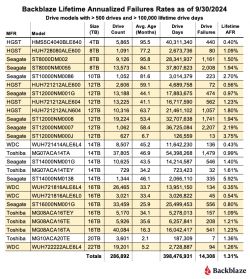FAQ
TL;DR: 1000-year M-DISC claim highlights archival trade-offs; “None. Hdd disks are not designed for such purposes.” Prefer 3.5-inch CMR, avoid SMR. [Elektroda, cysiekw, post #21398561]
Why it matters: This FAQ helps home users and small labs choose reliable, low-hassle storage for long-term backups and cold archives.
Quick Facts
- Typical 3.5-inch HDD annualized failure rate is approx. 1–2% in recent datasets; use this baseline when shortlisting. [Backblaze, 2023]
- Avoid SMR for archives; CMR omits the extra L2P mapping layer that adds risk during recovery. [Elektroda, kaleron, post #21381432]
- There’s no model-by-model failure table for 2.5-inch drives; for 3.5-inch, consult Backblaze stats. [Elektroda, cysiekw, post #21379105]
- For long-term archiving, use redundancy or switch to tape/M-DISC; a single HDD alone isn’t archival-grade. [Elektroda, cysiekw, post #21398561]
- 4TB CMR shortlists to consider: WD40EFPX, WD43PURZ, WD42PURU, and Seagate ST4000VN006. [Elektroda, cysiekw, post #21398378]
How can I tell if a 2.5-inch HDD model is good for archiving?
There is no authoritative failure table for 2.5-inch drives. Screen by design instead. Prefer CMR and avoid SMR. Avoid models flagged for weak mechanics. When possible, choose 3.5-inch CMR where reliability data exists. This simplifies risk assessment. If you must use 2.5-inch, plan redundancy. “Too much work and too expensive” to track 2.5-inch failures systematically. [Elektroda, kaleron, post #21381432]
Is there a big difference between 2.5-inch CMR and 2.5-inch SMR for long-term storage?
Yes. SMR adds a two-level logical-to-physical address translation that becomes a primary risk factor over time. Sustained writes and recovery scenarios are less predictable. CMR writes directly and avoids this extra layer. As one expert put it, “the primary risk factor is the two-level logical to physical address translation subsystem.” For archives, choose CMR. [Elektroda, kaleron, post #21381432]
Do 2.5-inch drives make sense for long-term backups?
They are a poor choice for long-term backups. The form factor brings higher constraints and fewer robust archival options. The advice in the thread is clear: pick 3.5-inch CMR instead. That path has better performance envelopes and real-world data to review. [Elektroda, soltyk, post #21433047]
Which specific 4TB CMR HDD models are worth shortlisting for archives?
Shortlist these 4TB CMR models: Western Digital WD40EFPX, WD43PURZ, WD42PURU, and Seagate ST4000VN006. These families target NAS or surveillance duties, which aligns with steady, reliable writes. Always confirm the exact sub-model before purchasing. [Elektroda, cysiekw, post #21398378]
I only need 500GB–1TB; what should I buy for archiving?
New 500GB HDDs are impractical today. Choose 3.5-inch 1TB CMR from the recommended series instead. Avoid 2.5-inch for archives. If budget is tight, consider used carefully only with redundancy. However, the most direct guidance is to start at 1TB in 3.5-inch CMR. [Elektroda, cysiekw, post #21398561]
Are the ST500LM030, WD10JPVX, or HGST HTS541010A99E662 good archive choices?
Of those, the Seagate ST500LM030 is highest risk. It uses SMR and has problematic mechanics, which should disqualify it for serious archival use. The thread does not endorse the other two. For reliability, shift to 3.5-inch CMR models. [Elektroda, kaleron, post #21381432]
Is there a model-by-model failure table for 2.5-inch HDDs?
No. There is no maintained failure table for 2.5-inch consumer models. For 3.5-inch drives, consult Backblaze’s published statistics as a reality check when comparing families. That public dataset does not cover 2.5-inch portable models. [Elektroda, cysiekw, post #21379105]
Can HDDs demagnetize in storage, and can I prevent it?
There is no such process as HDD self-demagnetizing. Focus on proven risks instead: mechanical wear, firmware issues, and handling damage. For long-term storage, reduce spin hours and ensure proper handling and redundancy. Avoid 2.5-inch portable drives for archival roles. [Elektroda, soltyk, post #21433047]
What should I use for truly long-term archiving instead of HDD?
Use tape or archival optical like M-DISC. The thread notes M-DISC’s 1000-year claim. HDDs are not designed for indefinite retention without maintenance. If you must use HDDs, use multiple CMR disks and redundancy. Test periodically and refresh copies as needed. [Elektroda, cysiekw, post #21398561]
Is the Samsung/Seagate ST1000LM024 a durable 2.5-inch option?
Some practitioners report the ST1000LM024 as the most user-resistant among 2.5-inch models they serviced. Treat such reports as anecdotal, not a guarantee. If you rely on 2.5-inch, still maintain multiple copies and validate health regularly. For safer archiving, pick 3.5-inch CMR instead. [Elektroda, laptokowiec, post #21380237]
Why do many recommend only 3.5-inch CMR drives for archives?
Because SMR complicates writes and recovery. CMR in 3.5-inch form factor has better-documented reliability and fewer pitfalls. As one expert summarized, “SMR is junk that no one should ever buy.” 3.5-inch families also have public stats to consult before buying. [Elektroda, cysiekw, post #21379105]
Is it safer to spread archives across many smaller drives?
Spreading data across multiple smaller drives lowers the blast radius of a single failure. You lose less when one disk dies. However, it increases physical space and management overhead. Note that 3.5-inch drives need external power, while 2.5-inch can be bus-powered. [Elektroda, użytkownik9, post #21432435]
How should I check archive drives for early warning signs?
Do a simple recurring health check:
- After purchase, check SMART and access times; repeat periodically.
- Note any slowdowns in listing or thumbnail generation.
- If access times worsen, copy data off and replace the drive.
These steps catch issues before data loss. [Elektroda, użytkownik9, post #21432435]
Where can I check real-world failure statistics before buying?
Use Backblaze’s public hard drive stats for 3.5-inch models. They have maintained failure statistics for years, which helps compare families. Review model-specific AFR trends, not just brands. Then combine with your workload needs and redundancy plan. [Elektroda, cysiekw, post #21432529]
What failure rate is “normal” for modern 3.5-inch HDDs?
Expect an annualized failure rate around 1–2% as a rough planning baseline, varying by model and age. Use this to size redundancy and test cadence. Always validate current-year reports, and avoid single-drive archives. Treat AFR as guidance, not a guarantee. [Backblaze, 2023]



